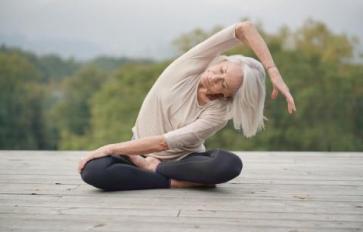
“I am fat. I am not the person you would typically imagine teaching or practicing yoga. Or even sitting behind a reception desk in a yoga studio.”
Yoga teacher Jessamyn Stanley can’t count the number of times potential students have seen her behind the desk, asked if she’s the one teaching the class, and failed to hide their surprise. Stanley can practically read their minds: “Dammit,” they think, “I guess I’m gonna have to pay this fat girl $15 to get a lackluster exercise experience.”
It’s common to pay lip service to the notion that yoga is for everyone, but we don’t always see this diversity reflected in its teachers or students, or catered to in classes.
Glancing at yoga’s history, it’s little wonder: modern asana first became mainstream as a grounding practice for rambunctious young boys in India (Stanley writes that women weren’t allowed to practice yoga until the twentieth century). Even today, postures can appear to favor a lean, boyish figure and, if you’re trying to replicate the poses you see on Instagram, maneuvering a womanly body into a deep twist or even a shoulder stand can feel like a joke.
But of course, the primary reason that yoga in America looks like a thin (usually white) female is our culture’s rigid definition of what constitutes beauty.
In Every Body Yoga (Workman, 2017), internationally recognized yoga instructor Jessamyn Stanley sets out to convince “people who don’t fit the typical yoga mold” that yoga is for them, and to show them how to modify poses for their body type. She recruits fellow teachers with “structurally unique” figures to model the postures outlined in the book, offering a timely reminder that “all yoga bodies deserve to be represented in print, not just those that are slender, female, and white.”
Stanley is challenging the “unspoken hierarchy where certain bodies matter and others don’t.” She knows what it’s like to go to a yoga class, “an environment that’s meant to foster calm and serenity,” only to feel excluded by a “vague sense of discrimination,” which makes her wonder if there’s something wrong with her.
Now she’s an acclaimed teacher who knows better, but she realizes that modern yoga culture can be intimidating, or downright harmful, for many people who could benefit from yoga. She suggests that beginners practice at “the most body-positive studio of all time: your home,” with your true teacher: yourself.
Stanley provides clear instructions and visuals to keep new students safe, and teaches the basics of yoga history and philosophy. For newbies wondering what props they need to buy, Stanley stresses that you don’t need any props (not even a mat) to practice yoga. However, she concedes, “Yoga is even more fun when you accessorize,” and she details where your money will be best spent: a great mat and bolster can take your practice to the next level, but there’s no need to spend a fortune on other props—According to Stanley, The Joy of Cooking, Harry Potter and the Deathly Hallows, and the Star Wars VHS box set all make great yoga blocks.
Stanley pays special attention to issues that particularly affect curvier women, such as misalignments caused by wishful thinking regarding hip size and shoulder width, or that pesky problem of “being choked by your own cleavage” during an inversion.
For me, one of Stanley’s most powerful points is that practitioners need to stop viewing their body size as a problem. “Being fat isn’t an injury or an impediment,” she writes. “Fatness merely needs to be accommodated.” An apologetic stance might indicate an injury of the mind rather than of the body.
As prefaces to asana sequences with titles like “I Want to Energize My Spirit” and “I Need to Chill the F Out,” Stanley shares her own experiences—awkward elementary years, the confusion and pain of the playground taunt “Oreo” (black on the outside, white on the inside), and the process of learning to love her natural hair. This is a book about trusting yourself and finding your sense of self-worth from within rather than relying on external factors like the media, romantic partners, or the bendy yogini next to you.
Stanley’s message is clear: “Your yoga journey is absolutely equal to anyone else’s, even if your body has a different physical presentation.” It’s a necessary reminder, although it’s sad we even need one.








